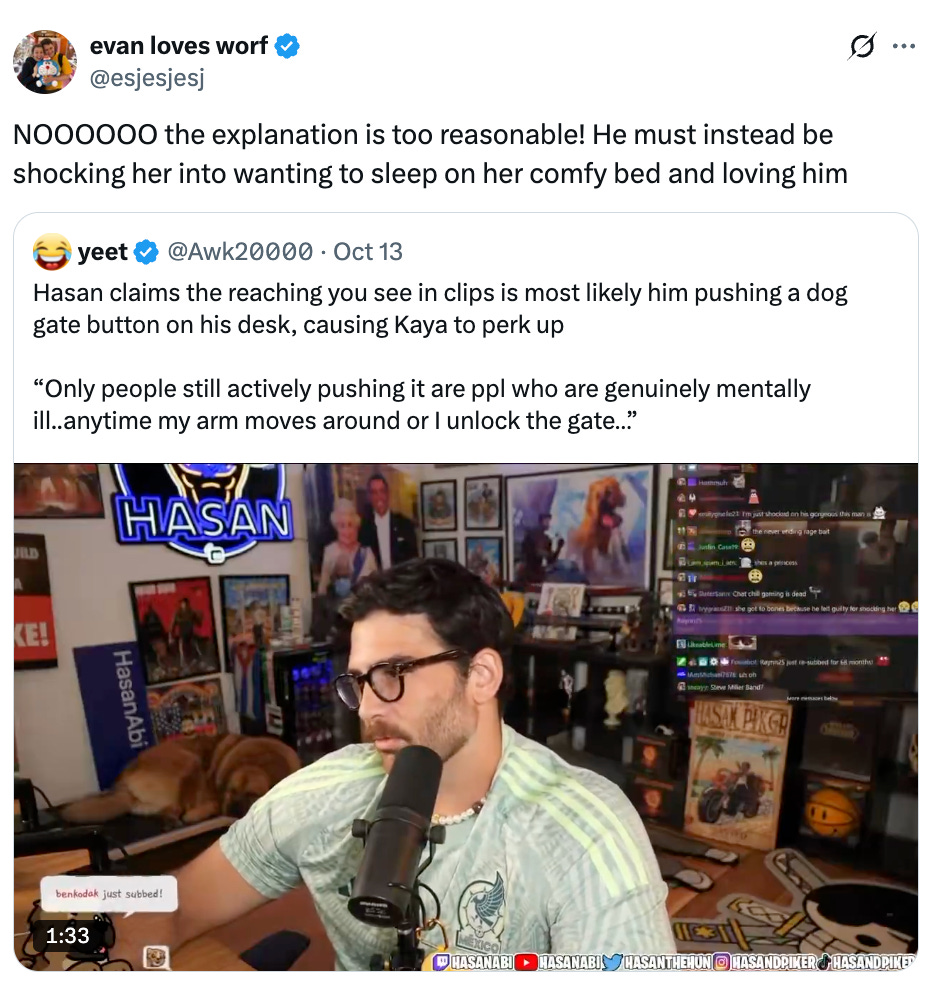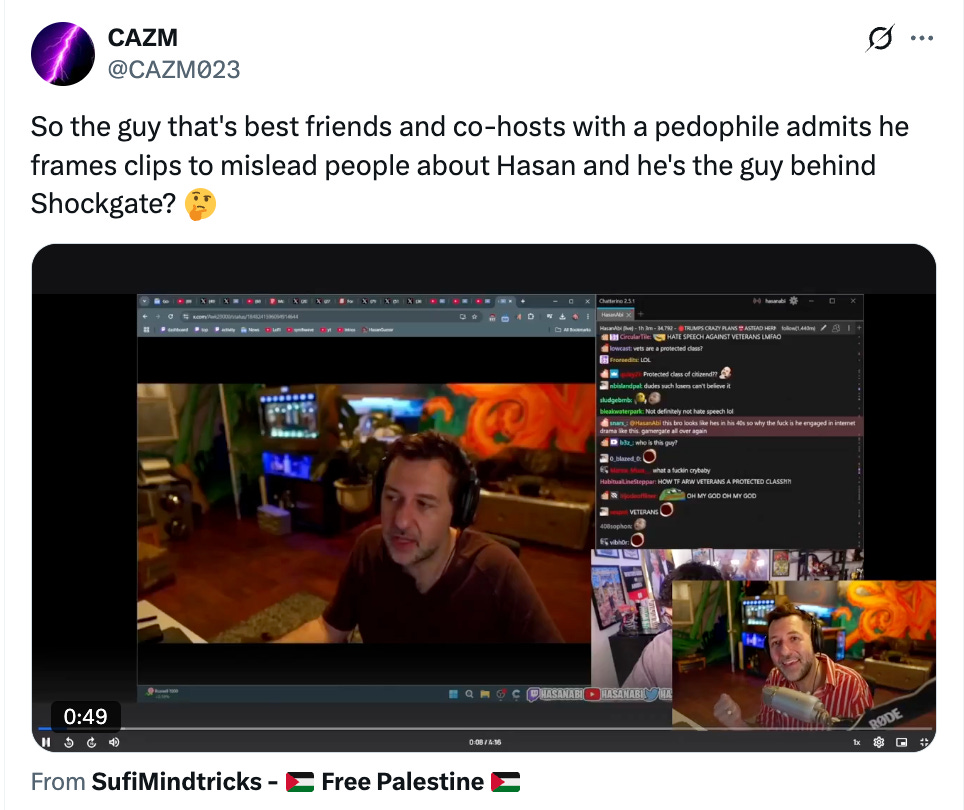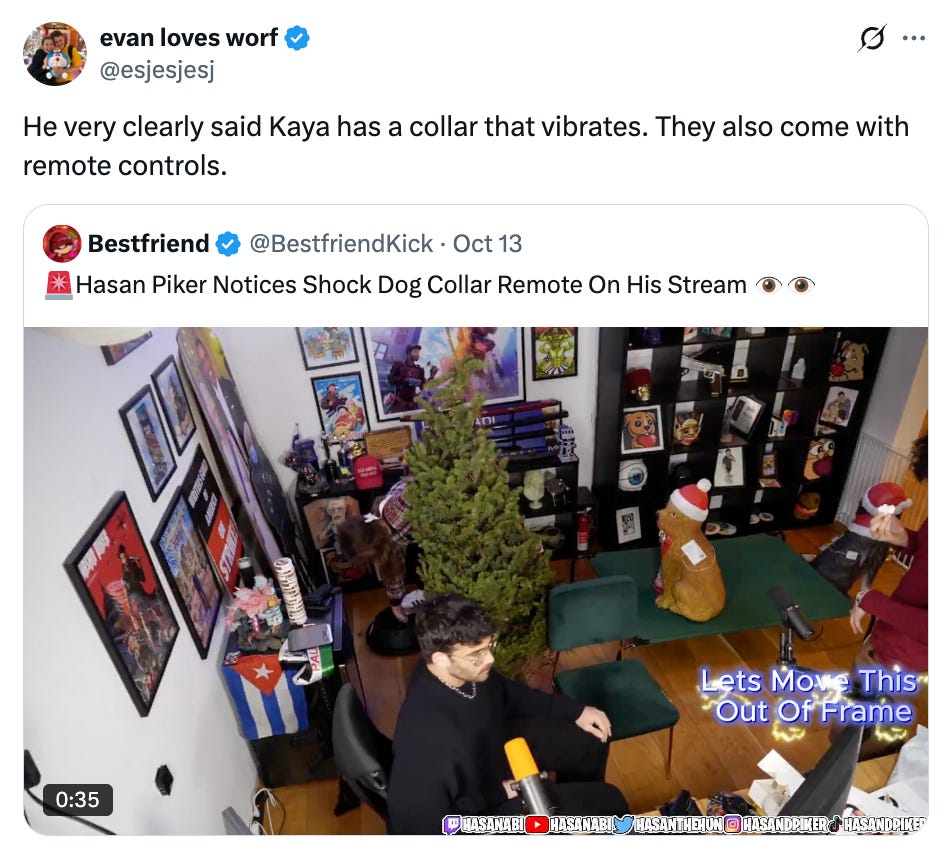Hasan Piker and the Future No One Is Ready For
The backlash that Piker is facing shows the consequences of a world where everyone is constantly being recorded and our internet is built to reward outrage and controversy.
For the past week the internet has been dominated by the conspiracy theory that Twitch streamer Hasan Piker abused his dog using a shock collar during a Twitch stream. There is zero evidence that the dog, Kaya, was wearing a shock collar in the clip. In reality, Kaya was wearing a canvas collar with an Airtag holder when she yelped once after seemingly catching her nail on her dog bed.
This one clip led to an army of internet-pilled weirdos crawling through tens of thousands of hours of footage claiming Piker secretly abuses his dog. Their “evidence” of this is not even the footage where Kaya yelps, it’s that in a few totally different clips, where Kaya doesn’t appear to be in distress at all, she’s wearing a collar with a small green light on it. Piker showed this collar on stream. It is an electronic vibration collar with zero shock capabilities. He uses it in the park for recall, when the dog is too far away to hear him, (the collar vibrates signaling it’s time to return home). Kaya also perks up when he presses the button on his desk to open his front gate, which is normal for a dog.
I’ve met Kaya IRL. I have never seen her in a shock collar. I have spoken to people who have walked Kaya, babysat Kaya, spent probably hundreds of hours with this dog, according to everyone I spoke to, in zero instances has she ever been shocked or abused. Not a single guest on Piker’s Twitch stream, in the years and years that he’s had Kaya, has said that they’ve ever seen Piker mistreat Kaya.
Attempting to debunk this conspiracy, however, has become largely impossible. You can’t prove a negative, and even after Piker publicly displayed the vibration collar, bad actors claimed that him putting a small piece of tape on the back to conceal his phone number, which is written on the device in sharpie, was evidence that he secretly modified and soldered down shock collar prongs, something that would be nearly impossible to do.
Nevertheless, the story has been weaponized by the far right to launch a multi platform smear campaign. Laura Loomer has posted relentlessly about it. Tech founder Palmer Luckey is offering $100,000 to anyone who can tear apart the vibration collar. Prominent Silicon Valley venture capitalists are weighing in. Posts pushing the conspiracy are among the most viewed posts of all time on subreddits like Livestream Fail. Israeli news sites have been mainstreaming the conspiracy along with a slew of low-quality SEO-driven platforms. Democratic influencers who are part of the 1630 Fund’s dark money influence campaign have also been pumping out this conspiracy content. Even PETA has weighed in.
Hasan has been subjected to politically-driven smear campaigns for years, but this latest manufactured controversy reveals a toxic new dynamic that I think will define the next era of the internet: outrage-driven gamergate-style social media hate campaigns combined with the 24/7 video surveillance machine. Twitch streamers like Piker are first to experience this destructive combination, but as more and more footage of everyone becomes available online, anyone who angers the wrong group could suffer a similar fate. Of course, all of this will be exacerbated by AI.
For years we’ve been told that constant video surveillance is a good thing, that it’s vindicating. Silicon Valley executives claim that widespread video recording will prevent abuse, harassment, crimes, etc. This has led to the mass adoption of police body cameras, 24/7 video capture on our streets, and a sprawling, crowd-sourced surveillance machine on social media. Social media platforms are actively incentivizing this surveillance, prioritizing video footage (and hours long livestreams) over every other content format.
Just last month, billionaire soon-to-be TikTok owner Larry Ellison said that a vast AI-fueled video surveillance system would ensure “citizens will be on their best behavior, because we’re constantly recording and reporting everything that is going on.” The comment is a perfect encapsulation of the delusional fantasy pushed by so many in Silicon Valley: that the surveillance state will be used for good.
This narrative is seductive. If we could just see everything in 4K, disputes over what “really happened” would collapse. If everything in life is videotaped and archived, then the real truth of these messy situations would be indisputable, proponents of surveillance culture claim. Piker’s dog collar incident shows that this theory is catastrophically wrong.
Almost no one is more surveilled than a Twitch streamer like Piker. He broadcasts almost every waking hour of his life. There are tens of thousands of hours of archived footage of him and his dog. When he leaves the house or goes out in public, fans video tape his every move. He documents his own life on social media, posting videos across Instagram and TikTok.
In theory, this should make it harder for bad actors to manufacture controversies. Such total visibility should make false accusations impossible. If everything is on record, then surely it would be easy for anyone to see the truth of the situation.
But the opposite is true. Instead of video being used as a tool to debunk conspiracies, it’s increasingly used as a tool to validate them. In Piker’s case, this has meant that an endless stream of years old clips are being repackaged and miscontextualized in order to further a politically-driven hate campaign. The dozens of out of context video clips spreading on social media, racking up millions of views, have become a digital Rorschach test.
“We are always given the same lie that somehow video is objective,” said Albert Fox Cahn, founder of the Surveillance Technology Oversight Project. “But the truth is there’s so much power in how it’s interpreted and edited. Even the most trivial form of tracking, even someone’s own Twitch stream, can turn into this weapon against them. Every camera is now a panopticon in the making.”
Josh Citarella, an artist and researcher who studies online communities and radicalization said that, “conspiracy theories and disinformation are flourishing because [endless] video archives are available. So long as the video archive exists, people can cherry pick and make these new narratives. If the videos didn’t exist or were closed, then the narratives wouldn’t seem credible. The possibility of people finding disingenuous clips to piece together a false story in even a marginally convincing way wouldn’t be possible.”
Because each new clip has the potential to go viral, and every major social platform incentivizes video, users across the internet are encouraged to participate in these crowdsourced forensic investigations. The hate campaign against Piker has already spawned a cottage industry of “video analysts” and Reddit internet detectives who have been pouring over every video frame and constructing elaborate conspiracy theories about what really happened.
The cycle is not entirely new. The tactics being used against Piker are ripped directly from the Gamergate playbook. The goal is to isolate a target, manufacture controversy, weaponize social platforms and the traditional media to spread lies, and orchestrate sustained, networked harassment with the eventual goal of making someone so controversial that they end up bankrupt and deplatformed.
But most Gamergate-style campaigns have traditionally relied on more text-based media or vague accusations about business dealings or journalistic practices. The bad actors might use a few screenshots, or some out of context comments, but the doctored “evidence” presented in these campaigns hasn’t traditionally been video in nature.
That has all changed with the rise of clip culture. The proliferation of this new medium and the sheer scale of the anti-Piker hate campaign shows that we’re entering a new era of the weaponization of the internet driven by attacks where video has undeniably replaced text as the raw material for conspiracy theories.
“With more footage being taken from more places and shared more widely, at a time where journalism and institutions are breaking, rather than being a way to bring us back down to ground, it ends up just fueling these conspiracy theories,” Fox Cahn said.
Influencers willingly monetize their own surveillance in order to turn their lives into content for profit. But, if we continue down this path, the experiences of Twitch streamers will become more common in everyday life. The weaponized internet will merge with the surveillance infrastructure we’ve built and ordinary people will live under the same microscope as influencers do today. As the couple at the Coldplay concert this past summer, or the security guard at Charlie Kirk’s final Turning Point event likely realized, there is no way to opt out of this new system.
AI will inevitably make all of this worse. Deepfake video generation tools are being rolled out en masse while media literacy plummets. Bad actors who are already comfortable manipulating real footage will begin fabricating videos of their targets or subtly altering them. AI will also make it easier to search, catalog, and weaponize every video ever recorded. Finding all available clips of someone making the wrong hand gesture, or wearing a specific color, or moving their body in a certain way could be as easy as clicking a few buttons.
If an influencer broadcasting tens of thousands of hours of his life for years can still be successfully smeared by a single misleading clip, what chance does a regular person have when a few seconds of their life go viral? What recourse do they have when they’re unjustly smeared? Institutional fact-based reporting outlets have been all but dismantled. Even when a journalist does debunk misinformation, audiences online are primed to fall for narratives driven solely by whoever can post the loudest and clip the fastest.
This type of clip-driven harassment can be incredibly profitable. Platforms like X, TikTok, and Instagram reward video views with cash payouts. Bad faith actors can rake in thousands of dollars by posting a flood of context-free shareable clips or dissecting video footage on a livestream.
Any clip, no matter how benign, can be reframed in service of a particular narrative. For example, on Monday, thousands of X users falsely claimed that a sound made by Twitch streamer AustinShow snapping his gum, was actually Piker pressing some sort of secret shock button.
The Piker controversy might read as mindless internet drama, but we are sleepwalking into a future defined by universal surveillance coupled with algorithmically incentivised online outrage. Our internet is devoid of privacy and video content specifically, is rewarded. Profit-driven tech platforms ensure that bad actors and extremists reign, and we’ve allowed tech oligarchs to dismantle all vestiges of a shared reality.
“The lesson of history is clear,” Cahn said, “this is only going to become a more prevalent problem for more people as the technology continues to get cheaper and more ubiquitous. What might seem like the absurd price of fame today, may soon become the inescapable price of participating in modern life.”








